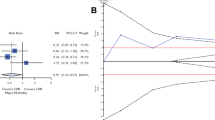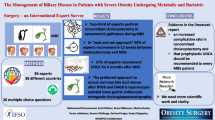Abstract
Background
Gallstone pancreatitis (GSP) is a common condition, accounting for 30–40 % of all pancreatitis cases. All GSP patients should undergo definitive treatment to prevent further attacks. This study aimed to investigate the long-term outcome after definitive treatment in England by cholecystectomy, endoscopic sphincterotomy (ES), or both.
Methods
Hospital episode statistics data were used to identify patients admitted for the first time with GSP between January and December 2005. These patients were followed for 18 months to identify those who underwent definitive treatment. Treatment groups then were followed until December 2010 to identify readmissions with a further GSP attack as an emergency or admissions with complications of gallstone disease.
Results
5,079 patients admitted with a first bout of GSP between January and December 2005. The in-hospital mortality rate was 7.8 %. Of those who survived the initial attack, 2,511 went on to have a cholecystectomy, 419 had an ES alone, and 496 had ES followed by cholecystectomy. Recurrent pancreatitis after definitive treatment was more common among patients treated with ES (6.7 %) than among those treated with cholecystectomy (4.4 %) or ES followed by cholecystectomy (1.2 %) (p < 0.05). Admissions with other complications attributable to gallstones in patients treated with ES alone were similar to those seen in patients who had received no definitive treatment (12.2 vs. 9.4 %).
Conclusions
Cholecystectomy offers better protection than ES against further bouts of pancreatitis in patients with GSP, but ES is an acceptable alternative. Interval cholecystectomy in patients treated initially with ES was the most effective method of preventing further pancreatitis, and the patients who underwent treatment by ES alone remained at risk of readmission with gallstone-related problems. Patients who have undergone ES and are fit for surgery should have a cholecystectomy.



Similar content being viewed by others
References
McKay CJ, Evans S, Sinclair M, Carter CR, Imrie CW (1999) High early mortality rate from acute pancreatitis in Scotland, 1984–1995. Br J Surg 86:1302–1305
Toh SK, Phillips S, Johnson CD (2000) A prospective audit against national standards of the presentation and management of acute pancreatitis in the South of England. Gut 46:239–243
Thomson SR, Hendry WS, McFarlane GA, Davidson AI (1987) Epidemiology and outcome of acute pancreatitis. Br J Surg 74:398–401
Corfield AP, Cooper MJ, Williamson RC (1985) Acute pancreatitis: a lethal disease of increasing incidence. Gut 26:724–729
Wilson C, Imrie CW (1990) Changing patterns of incidence and mortality from acute pancreatitis in Scotland, 1961–1985. Br J Surg 77:731–734
Moreau JA, Zinsmeister AR, Melton LJ III, DiMagno EP (1988) Gallstone pancreatitis and the effect of cholecystectomy: a population-based cohort study. Mayo Clin Proc 63:466–473
Judkins SE, Moore EE, Witt JE, Barnett CC, Biffl WL, Burlew CC, Johnson JL (2011) Surgeons provide definitive care to patients with gallstone pancreatitis. Am J Surg 202:673–677
Frei GJ, Frei VT, Thirlby RC, McClelland RN (1986) Biliary pancreatitis: clinical presentation and surgical management. Am J Surg 151:170–175
Howard JM (1987) Gallstone pancreatitis. In: Howard JM, Jordan GL, Reber HA (eds) Surgical diseases of the pancreas. Lea and Febiger, Philadelphia, pp 265–283
Hernandez V, Pascual I, Almela P, Anon R, Herreros B, Sanchiz V, Minguez M, Benages A (2004) Recurrence of acute gallstone pancreatitis and relationship with cholecystectomy or endoscopic sphincterotomy. Am J Gastroenterol 99:2417–2423
Davidson BR, Neoptolemos JP, Carr-Locke DL (1988) Endoscopic sphincterotomy for common bile duct calculi in patients with gallbladder in situ considered unfit for surgery. Gut 29:114–120
Uomo G, Manes G, Picciotto FP, Rabitti PG (1994) Endoscopic treatment of acute biliary pancreatitis in pregnancy. J Clin Gastroenterol 18:250–252
Hill J, Martin DF, Tweedle DE (1991) Risks of leaving the gallbladder in situ after endoscopic sphincterotomy for bile duct stones. Br J Surg 78:554–557
Vazquez-Lglesias JL, Gonzalez-Conde B, Lopez-Roses L, Estevez-Prieto E, Alonso-Aguirre P, Lancho A, Suarez FF, Nunes R (2004) Endoscopic sphincterotomy for prevention of the recurrence of acute biliary pancreatitis in patients with gallbladder in situ: long-term follow-up of 88 patients. Surg Endosc 18:1442–1446
Working Party of the British Society of Gastroenterology, Association of Surgeons of Great Britain and Ireland, Pancreatic Society of Great Britain and Ireland, Association of Upper GI Surgeons of Great Britain and Ireland (2005) UK guidelines for the management of acute pancreatitis. Gut 3:1–9
Kaw M, Al-Antably Y, Kaw P (2002) Management of gallstone pancreatitis: cholecystectomy or ERCP and endoscopic sphincterotomy. Gastrointest Endosc 56:61–65
Uomo G, Manes G, Laccetti M, Cavallera A, Rabitti PG (1997) Endoscopic sphincterotomy and recurrence of acute pancreatitis in gallstone patients considered unfit for surgery. Pancreas 14:28–31
Campbell SE, Campbell MK, Grimshaw JM, Walker AE (2001) A systematic review of discharge coding accuracy. J Public Health Med 23:205–211
Burns EM, Rigby E, Mamidanna R, Bottle A, Aylin P, Ziprin P, Faiz OD (2012) Systematic review of discharge coding accuracy. J Public Health 34:138–148
Peskett J, Davis H, Saunders P (2008) Findings of the national PbR data assurance framework: improving the quality of data underpinning payment by results using benchmarking to target clinical coding audits. BMC Health Serv Res 8:A22
Hansell A, Bottle A, Shurlock L, Aylin P (2001) Accessing and using hospital activity data. J Public Health Med 23:51–56
El-Dhuwaib Y, Deakin M, David GG, Durkin D, Corless DJ, Slavin JP (2012) Definitive management of gallstone pancreatitis in England. Ann R Coll Surg Engl 94:402–406
Lee JK, Ryu JK, Park JK, Yoon WJ, Lee SH, Hwang JH, Kim YT, Yoon YB (2008) Roles of endoscopic sphincterotomy and cholecystectomy in acute biliary pancreatitis. Hepatogastroenterology 55:1981–1985
Hammarstrom LE (2004) Endoscopic management of chronic and nonbiliary recurrent pancreatitis. Scand J Gastroenterol 39:5–13
Billi P, Barakat B, D’Imperio N, Pezzilli R (2003) Relapses of biliary acute pancreatitis in patients with previous attack of biliary pancreatitis and gallbladder in situ. Dig Liver Dis 35:653–655
Bignell M, Dearing M, Hindmarsh A, Rhodes M (2011) ERCP and endoscopic sphincterotomy (ES): a safe and definitive management of gallstone pancreatitis with the gallbladder left in situ. J Gastrointest Surg 15:2205–2210
Gislason H, Vetrhus M, Horn A, Hoem D, Sondenaa K, Soreide O, Viste A, Andren-Sandberg A (2001) Endoscopic sphincterotomy in acute gallstone pancreatitis: a prospective study of the late outcome. Eur J Surg 167:204–208
Welbourn CR, Beckly DE, Eyre-Brook IA (1995) Endoscopic sphincterotomy without cholecystectomy for gallstone pancreatitis. Gut 37:119–120
Lau JY, Leow CK, Fung TM, Suen BY, Yu LM, Lai PB, Lam YH, Ng EK, Lau WY, Chung SS, Sung JJ (2006) Cholecystectomy or gallbladder in situ after endoscopic sphincterotomy and bile duct stone removal in Chinese patients. Gastroenterology 130:96–103
Boerma D, Rauws EA, Keulemans YC, Janssen IM, Bolwerk CJ, Timmer R, Boerma EJ, Obertop H, Huibregtse K, Gouma DJ (2002) Wait-and-see policy or laparoscopic cholecystectomy after endoscopic sphincterotomy for bile-duct stones: a randomised trial. Lancet 360:761–765
Sanjay P, Yeeting S, Whigham C, Judson H, Polignano FM, Tait IS (2008) Endoscopic sphincterotomy and interval cholecystectomy are reasonable alternatives to index cholecystectomy in severe acute gallstone pancreatitis (GSP). Surg Endosc 22:1832–1837
Heider TR, Brown A, Grimm IS, Behrns KE (2006) Endoscopic sphincterotomy permits interval laparoscopic cholecystectomy in patients with moderately severe gallstone pancreatitis. J Gastrointest Surg 10:1–5
Disclosures
Abdalla Mustafa, Irena Begaj, Mark Deakin, Damien Durkin, David J. Corless, Richard Wilson, and John P. Slavin have no conflicts of interest or financial ties to disclose.
Author information
Authors and Affiliations
Corresponding author
Rights and permissions
About this article
Cite this article
Mustafa, A., Begaj, I., Deakin, M. et al. Long-term effectiveness of cholecystectomy and endoscopic sphincterotomy in the management of gallstone pancreatitis. Surg Endosc 28, 127–133 (2014). https://doi.org/10.1007/s00464-013-3138-6
Received:
Accepted:
Published:
Issue Date:
DOI: https://doi.org/10.1007/s00464-013-3138-6




